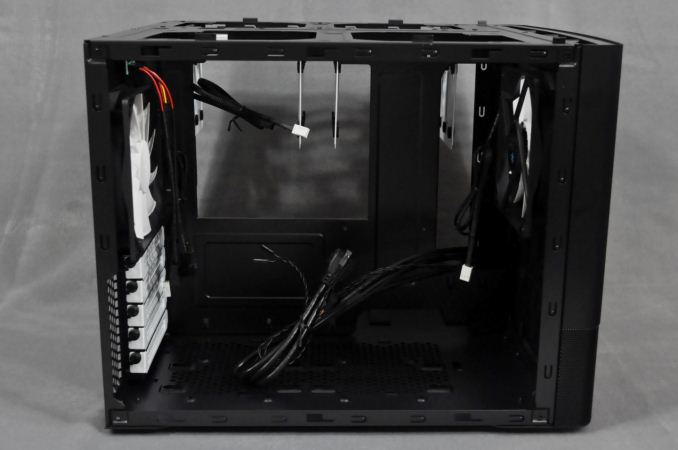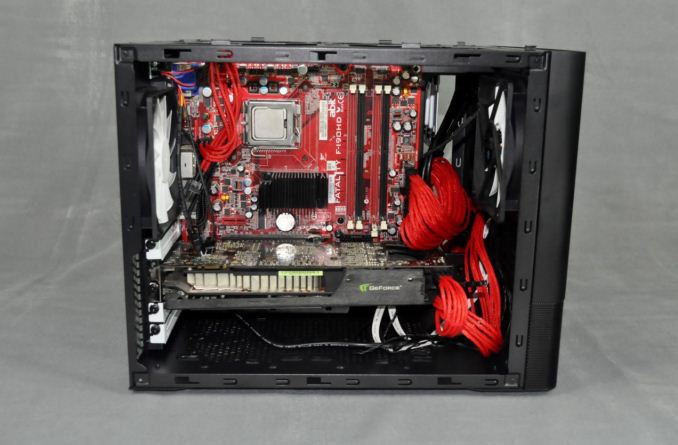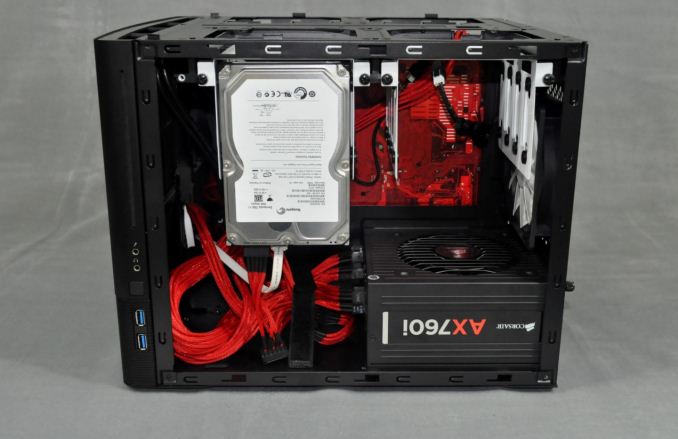Fractal Design Node 804 Case Review
by E. Fylladitakis on February 18, 2015 9:00 AM EST- Posted in
- Cases/Cooling/PSUs
- MicroATX
- Fractal Design
Fractal Design Node 804 Interior
For aesthetic purposes, Fractal Design enriched the black interior of the Node 804 with white accents. The blades of the cooling fans, the five expansion slot covers, and the HDD drive cages are glossy white, creating a striking but clean contrast with the rest of the case.
The motherboard tray can hold up to Micro-ATX motherboards. Instead of multiple small holes, the motherboard tray has just two openings – a massive opening behind the motherboard for the seamless installation of coolers and another to the right for the cables. Note however that the HDD cages will most likely need to be removed in order to reach the back of a motherboard for the installation of a cooler. The vents at the bottom of the left compartment cannot be used for the installation of fans, but two 2.5"/3.5" drives can be secured there using decoupling rubber rings.
The right compartment of the Node 804 is clean and straightforward, with a slot for the PSU at the lower right corner and two cages for up to eight 3.5" drives. The two white drive cages at the top of the cage are removable and can hold up to four 3.5" drives each. Decoupling rubber rings are used at every screw hole to minimize noisy vibrations. 2.5" devices cannot be installed on those two drive cages (without an adapter), limiting the SSD installation options to either the faceplate or the bottom of the left compartment. We should note that 3.5" drives are installed vertically, which makes cable management a little bit difficult, especially with the right cage that brings the drives very close to the PSU.
Vents, vents and more vents. No matter where you look, almost 85% of the whole chassis' exterior surfaces are vents. There are three 120mm fans in the Node 804, with slots for several more if necessary. Fractal Design also boasts that the Node 804 can hold up to four liquid cooling radiators simultaneously; what kind of systems exactly they assumed that would be installed in this case, we cannot imagine. There is a catch though – there are limitations on what radiators can fit and something needs to be sacrificed for each one of them.
For example, 280mm radiators can only fit at the top of the right chamber, but that requires the removal of the HDD cages. If that happens, only one HDD cage can be relocated to the bottom of the compartment and secured using the straps that normally are for cable management. At the top of the left compartment, only 240mm radiators will fit and they will also limit the height of memory modules to 48mm (and removing/installing RAM will require the removal of the radiator). Installing radiators at the front of the chassis limits the length of the expansion cards and prevents the installation of fans at the first slot of the top panel.
Black cables and parts are easily hidden inside an all-black chassis; therefore, for visual clarity, we are using an AX760i PSU with a red cable pack and white SATA cables for our pictures. Building a system inside the Fractal Design Node 804 is a fairly easy – as long as the system is relatively simple, without too many components. The addition of liquid coolers, too many drives ,and/or dual GPU setups could easily cause a stressful mess of things inside such a small case. Most of the time required to build a system should be for the routing of the cables. There are no sharp and or dangerous points about the Fractal Design Node 804 that we could locate during our experience with it.
As exhibited in the pictures of our test build, all of the cables are routed through the opening near the front of the case. This calls for a bit more careful planning regarding the cables near the bottom of the motherboard, but a few cable ties and patience can work marvels. The CPU 12V cable can go through a small opening at the top left side of the motherboard tray. Graphics cards up to 320mm can fit but cards longer than 280mm will partially block the opening for the cables and restrict the installation of an additional intake fan. Also, remember that CPU coolers taller than 160mm will not fit – and that is just about every top performance air cooler available today.



















72 Comments
View All Comments
randomlinh - Wednesday, February 18, 2015 - link
This is mostly not knowing how to photograph products. I know this isn't dpreview, but this is AT, not some run of the mill review site. My expectations for this site are that they do things professionally. Or, at least try to.chlamchowder - Wednesday, February 18, 2015 - link
Honestly this is not bad - they're not cell phone pictures, and (along with the text) got the job done in that they showed me I wouldn't want this case.Building with it seems a bit messy, and I'm not a fan of having front ports on the right side (if I sit to the left of the case, it's awkward).
The pictures could be stunningly good with more effort, but few review sites can consistently deliver that. While it'd be nice if AT could do that, I'm here more to look at what products offer, and the pictures meet the "good enough" standard. Past a certain point, getting better image quality takes more time/effort than it's worth, anyways.
just4U - Thursday, February 19, 2015 - link
I've never really noticed it.. pictures on here have seemed fine. They haven't taken a step back anyway... at least not that I can tell.Stuka87 - Wednesday, February 18, 2015 - link
Ahh, so I wasn't the only one to notice. Proper lighting is a must for a product review like this.wffurr - Wednesday, February 18, 2015 - link
How does it compare to the Bitfenix Prodigy?lewisl9029 - Wednesday, February 18, 2015 - link
I know this might be slightly off topic considering this review is for a mATX case, but personally I'd like to see more cases like the Silverstone ML08, RVZ01 that use PCI-E riser cards to minimize volume while supporting full-size GPUs.The gains a riser card makes in terms of sheer volume can make the difference between something that I can throw into a suitcase and bring with me anywhere vs something that I'd have to pack up and ship separately.
Silverstone's new FTZ01 looks very promising on this front: http://www.silverstonetek.com/product.php?pid=533
But I'd like to see more companies attempt these kinds of designs.
mpribe - Wednesday, February 18, 2015 - link
I own this case and use it for a gaming rig with an i5 4690k and a Gigabyte G1 Gaming GTX 970 in it, which is a very long card with 3 fans. The thing is very quiet even at full load running BF4 maxed at 70+ fps at 1200p.One crucial difference between this case and the Air 240 is that this one will accommodate lengthy graphics cards, while the Corsair case will not. Also, with space for 5 PCI Express cards, you can put in 2 video cards with room for each to breathe, while the Air 240 will have them mushed up against each other.
PPalmgren - Wednesday, February 18, 2015 - link
I had this on my short list for cases when I builty my living room PC, but ended up going with the Corsair Obsidian 250D instead. The 250D is quite large in terms of mini ITX cases, but it is smaller than this one and the 250D barely fit inside the cubbyhole on the side of my entertainment center where my old 360 was sitting.Has anyone who purchase this case ended up with size problems when used in a living room setting?
dave_the_nerd - Wednesday, February 18, 2015 - link
I use this case for a home server. It works fine and runs fairly cool, even with ten hard drives in it. I'm not looking forward to my first HD failure (what with the lack of hotswap bays and all) but otherwise I am a very satisfied customer.Also, it doesn't look like a gaudy gamer case.
nissefar - Wednesday, February 18, 2015 - link
Disagree. The window certainly screams mad gamer.